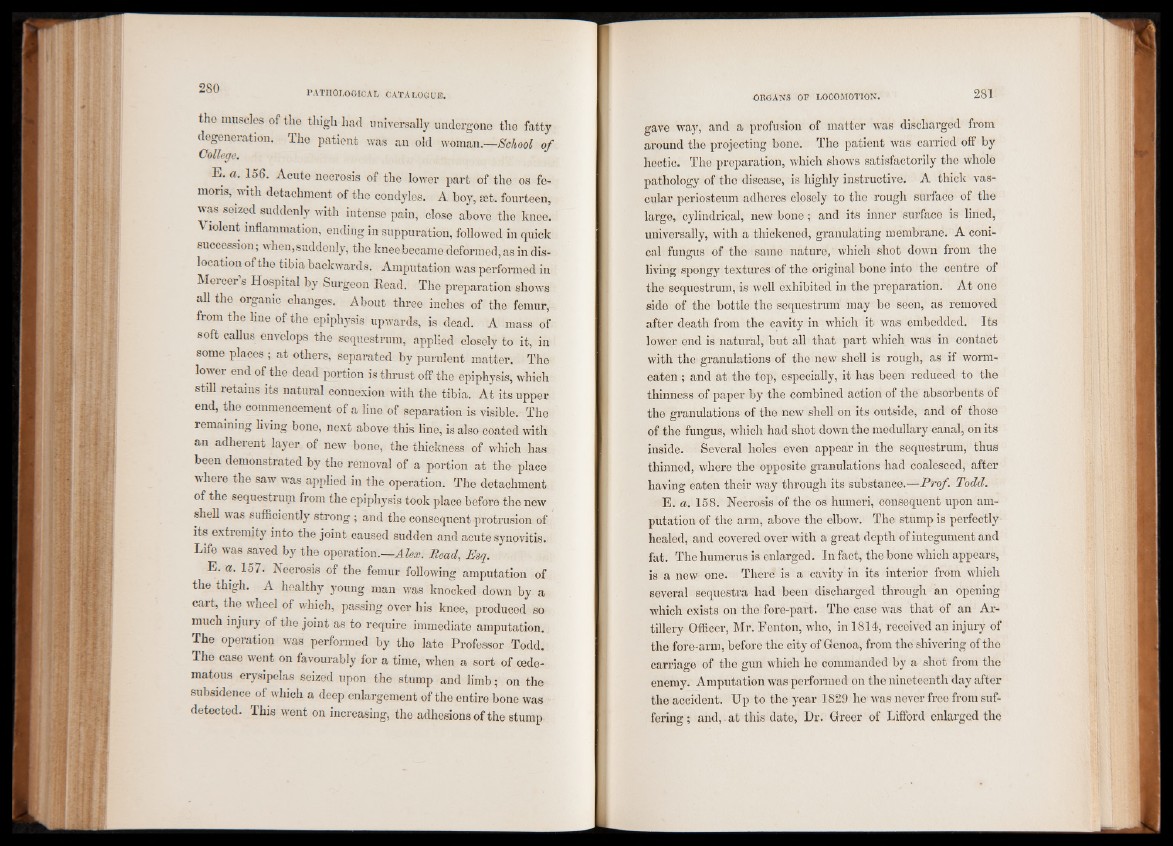
2S0
the muscles of the thigh had universally undergone the fatty
degeneration. The patient was an old College. woman.—School oJf
E. a. 156. Acute necrosis of the lower part of the os fe-
mons, with detachment of the condyles. A boy, set. fourteen,
was seized suddenly with intense pain, close above the knee.
Violent inflammation, ending in suppuration, followed in quick
succession; when,suddenly, the kneebecame deformed,as in dislocation
of the tibia backwards. Amputation was performed in
Mercer’s Hospital by Surgeon Read. The preparation shows
all the organic changes. About three inches of the femur,
from the line of the epiphysis upwards, is dead. A mass of
soft callus envelops the sequestrum, applied closely to it, in
some places; at others, separated by purulent matter. The
lower end of the dead portion is thrust off the epiphysis, which
still retains its natural connexion with the tibia. At its upper
end, the commencement of a line of separation is visible. The
remaining living bone, next above this line, is also coated with
an adherent layer of new bone, the thickness of which has
been demonstrated by the removal of a portion at the place
where the saw was applied in the operation. The detachment
of the sequestrum from the epiphysis took place before the new
shell was sufficiently strong ; and the consequent protrusion of
its extremity into the joint caused sudden and acute synovitis.
Life was saved by the operation.—Alex. Read, Esq.
E. u. 157. Necrosis of the femur following amputation of
the thigh. A healthy young man was knocked down by a
cart, the wheel of which, passing over his knee, produced so
much injury of the joint as to require immediate amputation.
The operation was performed by the late Professor Todd.
The case went on favourably for a time, when a sort of oede-
matous erysipelas seized upon the stump and limb; on the
subsidence of which a deep enlargement of the entire bone was
detected. This went on increasing, the adhesions of the stump
gave way, and a profusion of matter was discharged from
around the projecting bone. The patient was carried off by
hectic. The preparation, which shows satisfactorily the whole
pathology of the disease, is highly instructive. A thick vascular
periosteum adheres closely to the rough surface of the
large, cylindrical, new bone; and its inner surface is lined,
universally, with a thickened, granulating membrane. A conical
fungus of the same nature, which shot down from the
living spongy textures of the original bone into the centre of
the sequestrum, is well exhibited in the preparation. At one
side of the bottle the sequestrum may be seen, as removed
after death from the cavity in which it was embedded. Its
lower end is natural, but all that part which was in contact
with the granulations of the new shell is rough, as if worm-
eaten ; and at the top, especially, it has been reduced to the
thinness of paper by the combined action of the absorbents of
the granulations of the new shell on its outside, and of those
of the fungus, which had shot down the medullary canal, on its
inside. Several holes even appear in the sequestrum, thus
thinned, where the opposite granulations had coalesced, after
having eaten their way through its substance.—Prof. Todd.
E. a. 158. Necrosis of the os humeri, consequent upon amputation
of the arm, above the elbow. The stump is perfectly
healed, and covered over with a great depth of integument and
fat. The humerus is enlarged. In fact, the bone which appears,
is a new one. There is a cavity in its interior from which
several sequestra had been discharged through an opening
which exists on the fore-part. The case was that of an Artillery
Officer, Mr. Fenton, who, in 1814, received an injury of
the fore-arm, before the city of Genoa, from the shivering of the
carriage of the gun which he commanded by a shot from the
enemy. Amputation was performed on the nineteenth day after
the accident. Up to the year 1829 he was never free from suffering
; and, at this date, Dr. Greer of Lifford enlarged the